
#Linux cpu stress test install
You can run the below-mentioned commands on the terminal shell to install the Sysbench tool on your Debian-based machine. This tool will give you accurate results for CPU hardware testing. $ sudo apt install s-tui stressįinally, run the below-mentioned command to see the CPU stress test results on your Linux machine. Here you can see the command provided below will let you install the S-tui on Debian Linux. You can get it on your Linux system through conventional and Python Pip methods. The S-tui is a python-based terminal tool for testing the CPU stress on Linux. The below-mentioned command will give you the stress timeout value. You can also check the CPU load for other CPU threads with a customized timeout value. Now, to get the CPU-wise stress check update, you can execute the below-mentioned command. First, you will need to get the Stress tool on your Linux machine.
#Linux cpu stress test how to
Here we will see how to check the CPU stress with the Stress tool.

You can run the next command to check the load of the multi-threaded CPU. To check your machine’s single-threaded CPU load, run the below-mentioned command. If you don’t have the tool installed, you can get it on your machine through the below-mentioned command. But did you know that this tool can also check the CPU details and stress testing on Linux? You can now check CPU load and metrics with the 7-zip. We all know that the 7-zip is widely used for zipping, unzipping, and extracting files. The below-provided command will run an auto-generated CPU load and stress test result on the shell. Now, run the below-mentioned commands on the terminal shell to install the GTKStress Testing tool on your Debian-based machine. Sudo apt install gnome-software-plugin-flatpak sudo apt install -reinstall ca-certificatesįlatpak remote-add -if-not-exists flathub You will also need to get the FlatHUb package. sudo add-apt-repository ppa:flatpak/stable

If you don’t have the Flatpak installed on your machine, please ensure that you know everything about Flatpak and how to install it on Linux. To install the GTK stress testing tool, we will use the Flatpak method. Now, when the installation ends, you may now check the CPU stress capability with the below stress-ng command. You can install in on your machine with the below-mentioned command. Stress-NG is another command-line-based Linux CPU stress testing tool. It may take a while to load all the default parameters, so show you the CPU load and stress test. Now, after the installation ends, you can run the Phoronix tool on your machine. $ sudo gdebi phoronix-test-suite_9.8.0_all.deb You can execute the below-mentioned commands on the terminal shell with root privilege to install the Phoronix tool on your Debian-based machine. The Phoronix tool is one of the most used tools for CPU benchmarking and stress testing. In this post, we will see how to check the Linux CPU stress test, and we will also see a few tools for Linux hardware benchmarking. Please make sure that you are a root user on your system.

Running a few applications for performing the stress results might need you to have root access at the Sudo permissions. To run a successful stress test on a Linux system will need to operate a few recognized and trusted applications on a Linux system that can show us the stress results. On the other hand, stress testing is a process where you can ensure how much stress your CPU, Ram GPU, and other components can take for an overloaded situation. You can check and get the hardware metrics data on global parameters to ensure that the manufacturers are giving you a quality product. In the benchmark result, you can verify that your specific hardware component is performing as expected to perform. The benchmark results actually give you a value of a result that you perform to check the strength of specific hardware. Many people think that the benchmark and stress testing are the same for Linux and other operating systems.
#Linux cpu stress test free
As the Linux systems are free and open-source, the developers build different distributions with different-level hardware optimizations. The CPU stress tests are mostly run by the developers and programmers who need to know the durability and strength of a system before releasing this publicly.


 0 kommentar(er)
0 kommentar(er)
